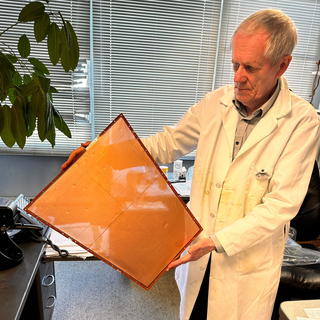Smirnov celebrated for 33 years at Yale

Wright Lab research scientist Nikolai Smirnov is retiring this Fall after thirty-three years of working at the Yale Physics department.
Below is a tribute composed by Wright Lab Relativistic Heavy Ion Group faculty Helen Caines, Horace D. Taft Professor of Physics; John Harris, D. Allan Bromley Professor Emeritus of Physics; and Laura Havener, assistant professor in physics.
Today we celebrate the 33 years that Dr. Nikolai Smirnov has been a member of the physics department at Yale and wish him a long and happy retirement.
Nikolai received his Ph.D. in 1978 from the Leningrad Nuclear Physics Institute (now known as the PNPI or Petersburg Nuclear Physics Institute) in St. Petersburg in what was at that time the Russian Federation. He then worked at FNAL, CERN, and BNL before arriving in 1992 to Yale. He has been an integral member of the Relativistic Heavy Ion research group in Wright Lab since 2001.
Nikolai has been a member of several different fixed-target and collider-based nuclear physics collaborations, including making significant contributions to the designs of L3, PHENIX, STAR, ALICE and ePIC, which gave him the enviable opportunity of witnessing first collisions at three different accelerator complexes—LEP, RHIC, and the LHC.
Nikolai has a passion for hardware; you will find him in the lab at almost any hour of the day or night, including weekends, and has been a pivotal member of more R&D activities at Wright Lab than it is possible to mention in this article. Recent highlights include responsibilities for the testing and calibrations of ALICE’s EMCal supermodules; construction of 26 inner read-out chambers for ALICE’s GEM TPC; serving as a consultant during the construction of sPHENIX’s TPC at RHIC; and serving at STAR, until today, as a shift leader and the on-call expert for the GEM tracking detector.
When not hard at work in the lab, Nikolai has helped supervise a number postdocs and students, and some junior faculty, ensuring that when they left Yale they knew not only how to perform data analysis but had also gained vital hands-on experience with detectors. In addition, he is a loving grandfather, and we are sure they will adore the extra time they get to spend with Nikolai during his retirement.
Nikolai will be sorely missed by all members of Wright Lab, but particularly by the Relativistic Heavy Ion group, where every member has gained from the opportunity to work side-by-side with Nikolai in the lab and/or discuss new ideas over coffee.
Nikolai, we wish you all the best and hope that you will continue to be seen regularly in the lab showing us how R&D should be done.
Helen, Laura, and John